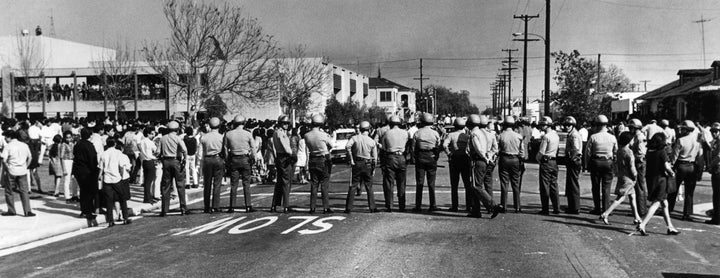
History repeats itself. I often tell my students this when I teach Latino studies every day at three different high schools in the San Gabriel Valley of Los Angeles County. Latino studies is a fairly new class in a district where 92 percent of students are Latino, many of Mexican descent. Yet there are still those who would say that classes like these don’t belong in our schools.
An important history lesson I give my students is about the East Los Angeles walkouts of 1968. Fifty years ago, Mexican-American students were fed up with unequal conditions of their schools, including high push-out rates, racist and discriminatory attitudes or practices of school staff, not being reflected in the school curriculum and being tracked into vocational and special education classes. From March 1 to March 8, more than 15,000 students walked out of five high schools: Belmont, Garfield, Lincoln, Roosevelt and Wilson. They sparked a larger movement across the Southwest and inspired generations.

The walkouts paved the way for students like my parents, who would later walk the halls of those very same schools in East LA. My mother and father went to Garfield and both had the opportunity to attend some college. Had the walkouts not happened, my parents might not have had these opportunities. They instilled in me the importance of education and where we come from, so that I, a Xicana, believed that one day I could obtain a doctorate.
The walkouts were a point in history when Mexican-American students decided that enough was enough. This tradition of speaking out against injustice continues, as we have recently seen with the students in Parkland, Florida.
Fifty years later, Mexican-American/Chicano and Latino students are still facing discriminatory and differential education. If these students don’t know about their history, how will they know how to push back against the narratives that tell them they are less than? What will they do when they are still tracked into vocational classes and away from college preparatory classes in our schools and told they are not college material?
“As time has passed, we have not made much progress, and perhaps we have gone backward.”
Latino students in the U.S. attend some of the most segregated schools, according to a report from the Civil Rights Project at the University of California, Los Angeles. The researchers found that Latinos in schools are more segregated now than they were in 1970. In California, there’s been an “extremely dramatic increase in the segregation of Latinos, who on average attended schools that were 54 percent white in 1970, but now attend schools that are 84 percent nonwhite,” the Civil Rights Project says.
The report also states that Latino students in California attend schools where the majority of the students are poor. This means that Latinos continue to attend schools that are under-resourced, limiting their opportunities for options beyond high school that could change their socioeconomic status.
We can see that as time has passed, we have not made much progress, and perhaps we have gone backward.
Living in an era in which anti-immigrant and specifically anti-Mexican or anti-Latino sentiments have become a common occurrence, I wonder how this affects the students I teach every day. I wonder this because we know that a person can become our country’s leader after saying that Mexico is “not sending their best. They’re sending people that have lots of problems and they’re bringing those problems.” What are we as a country really saying?
Chicano and Latino history in the U.S. has been a history of feeling unwelcome and experiencing unequal treatment. Segregated schools for Mexican-American children were supposed to be a thing of the past after 1947’s Mendez v. Westminster challenged that they were not only discriminatory, but also harmful.
I was a middle school student during the time of Proposition 187 in California, which would have made it illegal to provide education, non-emergency health care and other services to anyone suspected of being undocumented. In 1994, I walked out of class in protest with fellow classmates, but we were locked in the school by gates that separated us from the street. We stood and watched the students from the high school march by on their way to a rally with other local schools. During that time, it is estimated over 10,000 students in Southern California walked out against Proposition 187.
As a college student in 2006, I participated in marches against HR 4437, a bill sponsored by Rep. Jim Sensenbrenner (R-Wis.) that called for increased militarization of the border and criminalization of undocumented people and anyone assisting them. These protests spread across the U.S., where hundreds of thousands of people marched and more students walked out of their schools.
“Students must be empowered by history and the knowledge that something can be done to make a change.”
Some would say students who walk out don’t know why they are protesting, but students know more than we think they do. Commercials for Proposition 187 on TV told Mexicans and other immigrants that they were unwanted, and I saw that my classmates were scared enough to stop coming to school out of fear of arrest and deportation. And the protests of Proposition 187, like the walkouts of 1968, did help to change things for the better. The school district that I attended implemented the first-ever Chicano studies class for students, which I enrolled in during its first year as a high school freshman.
Years later, I find myself as a high school Latino studies teacher in my first year. I have told my students the history of Mexican presence in the Southwest predates 1848, when under the Treaty of Guadalupe Hidalgo, the region became part of the U.S. Our history here is part of U.S. history, and yet we are excluded from textbooks and curriculum.
I didn’t plan to teach high school after my doctorate, but it is part of a continuing legacy. In my day to day, I see the importance of ensuring that students know not only the injustice that our communities continue to face, but that they are empowered by history and the knowledge that something can be done to make a change. I see them coming back to themselves with each week, each day, connecting the past to the present and realizing they are brilliant and capable, although some students have shared that they have sometimes been made to feel otherwise. At the beginning of the year, I would only get a few hands at each high school when I asked who plans to go to college. Now I get almost all of their hands in the air. There are still many challenges, and they will be the generation to carry things forward.
The stakes are high. Our communities continue to be attacked, but there is hope because there are people who care. A bill introduced by California Assemblymember Jose Medina (D) would make ethnic studies a graduation requirement for the state’s high schools. In Texas, a group of activists and educators continue to advocate for Mexican-American studies courses after many challenges. In Arizona, there is an ongoing battle for reinstating Mexican-American studies in schools after a district judge ruled in August that the abolishment of the classes was discriminatory and violated the students’ First and 14th Amendment rights.
The legacy of resistance continues. It has forced me to change what I tell my students about history repeating itself. History repeats itself until someone defies it, and we have a long history of doing just that.
Irene Sanchez is a mama, educator, poet and writer. She is the founder of Xicana Ph.D. You can follow her on Twitter at @irenemonicas.
